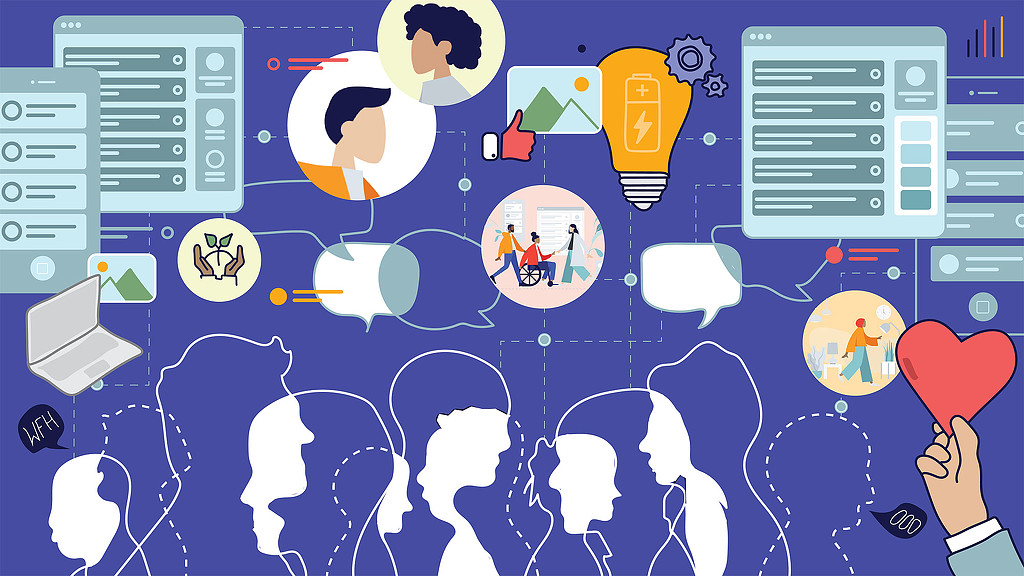The Future of Workplace Amenities Is Knowledge
October 15, 2020 | By Sarah Brengarth, Shelby Burnett
To compete for top talent, employers have traditionally offered workplace amenities such as corporate gyms, gaming lounges, nap rooms, and other in-office perks. But today, after months of working from home, our expectations of the workplace and what it means “to work” and “be in a place” are facing an unprecedented shift. As we navigate this shift, workplace experience is taking center stage — driving whole narratives on what “experience” should look like for each employee in a more hybrid work model, one that merges the best of “work” and “home” and looks to extend beyond physical space to support employees more holistically.
As more businesses embrace flexible work, things like employee choice and well-being are taking precedent over the physical amenity spaces that companies once offered. Instead of valuing things, employees are more likely to value great workplace experiences. Things like equity, mentorship, and learning are moving up the list of employee priorities now that our work and home lives have become seamlessly and intentionally interconnected.
As the lines between our work and home lives become increasingly blurred, companies must harness the capability of new digital tools and create the potential for growth, holistic well-being, and self-actualization as the primary amenities they can offer their employees.In this new landscape, one of the most valuable amenities is knowledge.
With these things in mind, we’ve been thinking more about what the future workplace amenities should be, especially as physical environments are rapidly changing.
Here are four considerations:
1. Leverage technology to work smarter, not harder.Our work lives are often strained by workplace applications that are marketed as a way to make us more productive. Yet we find ourselves spending hours on unnecessary tasks. What if we could optimize technology to relieve ourselves of the trivial tasks that clutter our minds and hold us back from focusing on meaningful work?
For example, we can leverage AI technology to understand our daily routine and work habits. What if technology could step in to auto schedule meetings, take notes during presentations, or even plan out our calendars based on our habits? What if technology could help notify employees of ideal days and times to be in the office according to their schedule, their team’s schedule, or project timeline? Having technology assist with these tasks could support team communication and help with transparency.
What if there was just one app that did it all, instead of using so many types of software and applications that convolute the workflow and create unnecessary actions? What if this app could help automatically file documents, presentations, and project emails where everyone could easily find them? Having one app could help increase efficiency, ease collaboration, and ideally reduce the learning curve for staff.
How might the AI-powered workplace bridge the experience of employees working in-office and those working remotely? What if there was a virtual getaway feature, allowing employees to “drop in” to the London office for the week? This could include “virtual coworking,” or an “experience in a box,” allowing remote workers to experience office culture virtually and participate in crafted experiences that are tied into the physical workplace.
As we continue thinking about the future of work, one thing is certain: we must leverage technology as a platform to maximize employees’ time and efficiency in order to better support them and their work.
2. Sensors and data should foster a sense of safety.Data is playing a bigger role in the design, operation, and human experience of the workplace. Here are a few ways in which companies can leverage data to transform employees’ work experience:
- Support people with data and leverage AI to empower employees as individuals.
Digital amenities, such as internal social platforms that allow workers to connect with others and on-demand workplace services that support employees from wherever they are working have become imperative to help maintain company culture as companies move into a hybrid working model. Data and AI technologies need to expand beyond the physical office space to support employees in their everyday lives no matter when, where, or how they choose to work.
- Integrate data and service to cultivate a work environment that promotes health and safety for all.
Companies must leverage data in a transparent and accessible way to instill confidence in employees. Can we optimize facility and operational systems to respond to varying office occupancy? Can we harvest intelligent data from these systems to communicate to employees how the physical office is functioning before they choose to enter the space? As more employees work remotely, organizations will need to consider these questions and share information proactively to help people plan their schedules.
- Unify data and design to create work experiences that better learn and adapt to business change and our unexpected futures.
We need to use data to help plan for future realities both in and out of the office. Can we create digital twins of our office spaces so employees who are working from home feel connected to a community? Can we seamlessly integrate employee experience surveys to better tailor apps and companywide communication to suit each individual’s needs?
The en masse shift to remote work has introduced an interesting dichotomy in how we engage with our peers. On one hand, we are collaborating like never before, proving the ability to work without geographic boundaries. Teams are no longer limited by physical presence and can now be structured on what each individual brings to the table, regardless of location. This gives whole new meaning to the concept of “expanding your network,” with seemingly limitless potential for growth. On the other hand, we are craving the serendipity of the workplace, the casual collisions that lead to spontaneous conversations and unforced collaboration.
This dichotomy leads us to believe that our current tools are falling a bit flat. So, with virtual networks expanding exponentially, how do we facilitate more meaningful connections with our colleagues and gain back some of the spontaneity of the physical office?
What if companies created internal social platforms that allowed employees to expand their network and provided more opportunities for seamless interactions and collaboration? Could employees create workplace profiles and instantly connect with others in the company who live in the same neighborhood or have a similar interest? Acting as a digital extension of the physical workplace, could a virtual assistant nudge employees to interact with colleagues based on a variety of metrics, such as daily habits, professional goals, or mutual connections?
Could app-based solutions help people know their neighborhood better by providing recommendations on lunch spots, local hangouts, or delivery services? Could they facilitate office rituals and create entirely new ones, from coffee chats, to group workouts hosted in person or livestreamed to connect employees, regardless of where they are working?
As we navigate a hybrid work future, technology can enhance both our work at home and in the office; allow for a seamless and fluid transition between each of these modes; and keep us connected to our teams, our communities, and our individual needs.
4. Self-actualization becomes a cornerstone to company culture.The past several months have taught us much about prioritization and understanding what motivates us in our work and lives. For many, it’s been a confusing time of feeling less focused, undermotivated, isolated, and lonely.
In a survey by ValuePenguin, more than half of respondents said their mental health is suffering due to the pandemic. Additionally, Deloitte’s 2020 Global Human Capital Trends found that 93% of the organizations surveyed identified “sense of belonging” as a key driver to organizational success moving forward, but only 13% say they are very ready to address this trend. The workplace must make a tangible shift, and organizations must take responsibility in helping their employees heal and remedy the inequities in experience that have come to light during this global crisis.
So, how do companies successfully pivot and provide opportunities for employees to pursue self-understanding? It is essential to create spaces that are welcoming, judgement-free, and truly accepting of all. Leadership and policies must be redesigned to support mental wellness. Internal platforms need to be fueled by purpose, supporting employees as “whole humans” in how they work, live, engage, and feel.
Can companies support employees holistically through team therapists, life coaches, nutritionists, community managers, or entirely new roles? How can they restructure teams and traditional metrics of success so that employees truly understand how they are uniquely suited to add value and support their projects, teams, and organizational goals?
Forward-thinking organizations must start with the individual in order to support the larger goals of the team and organization. As we equip employees to better understand themselves, we create an environment where they can better empathize with their fellow coworkers. By prioritizing acceptance, purpose, and productive autonomy, we can facilitate discovery, innovation, and thoughtful intention throughout the workforce.
Embracing the idea of knowledge as amenity — knowledge of ourselves, our peers, and our environments — will help us align and empathize with the individual and the organization, lead with conviction, and regain a bit of the humanity we may have lost in our previous unwavering focus on productivity.
Amenities should be vessels for communicating a company’s culture by responding to what employees are craving most: the freedom and acceptance of choice. We must empower individuals to be where they want to be, when they need to be, and be seen as they so choose, and we must fully equip them with a reimagined set of tools, policies, and the physical and digital spaces to embrace their best, whole selves.
For media inquiries, email .

